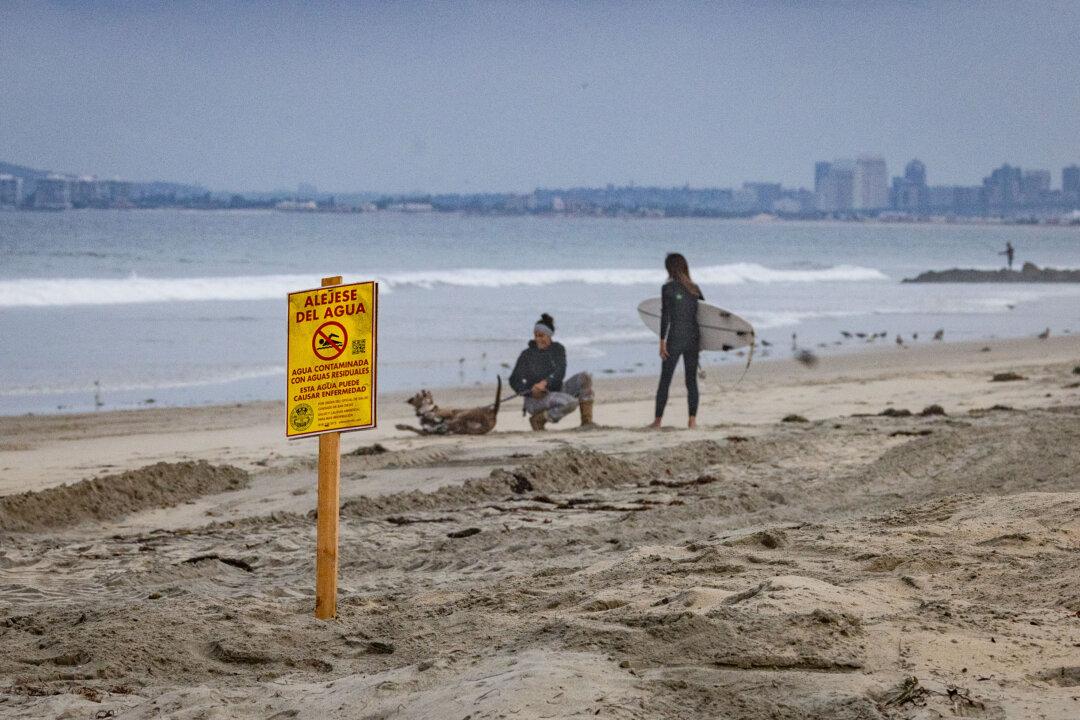RANCHO CUCAMONGA, Calif.—Jessica Equils is a fifth-grade teacher in Rancho Cucamonga, California, guiding her students through classes from home while taking care of her own children—three of them, all under the age of 6.
“I thought teaching was tough, then I taught with three kids at home,” she told The Epoch Times as her 4-year-old daughter circled her chair in the search for a lost coloring book.

Fifth-grade teacher Jessica Equils teaches her class online from her home in Rancho Cucamonga, Calif., on Aug. 3, 2020. John Fredricks/The Epoch Times
It was the first day of school for her district, the San Bernardino Unified School District, on Aug. 3, and she started the day helping her students through technical difficulties.
“It was a lot for them technology-wise,” she said. “They had a lot of questions about how to use the programs and computers. They have never had to be solely dependent on technology before.”
The tech problems were minor, however, and they got into a timed writing exercise as their first task without a very long delay.
Many of them have parents who work during the day, often outside of the home. Equils worries about her students being on their own and she saw last semester that, without help and monitoring, many of her students weren’t present for their studies.
“We are not with them for eight hours a day anymore, so we cannot keep an eye on them throughout the week,” she said. Only eight of her 33 students were consistently present during spring distance-learning.
Another big factor in poor attendance last semester was lack of access to computers and WiFi. “No internet means no school right now,” she said.
Ahead of the fall semester, more than 56,000 laptops and 94,000 WiFi hotspots have been distributed by the government to families statewide.
So far this semester, Equils has seen better attendance, but not 100 percent. She said all of her students now have computer access, but a couple of them still lack consistent WiFi access.
She has 32 students this semester, and as of Aug. 21, one of them had never attended class. Another has persistent connection issues in a home with four school-aged siblings also using the internet for classes. She’s had other students occasionally absent.
In her school district, 43 percent of parents had selected distance learning as the preferred option, according to a video message from Superintendent Harold J. Vollkommer.
Equils’s husband, Brandon Equils, is also a teacher. He’s a highschool teacher at Monrovia Unified School District in Los Angeles County, and his classes started online Aug. 19.
He is meeting with his students one hour on Mondays and three hours per day Tuesday through Friday.
Between their online meetings, the students have carefully structured assignments Equils has given them to work on, and students can connect with him during his online office hours for help with schoolwork.
He begins each school day with a mandatory student check-in, including a questionnaire. “Part of the daily check-ins I have with my students features a multiple-choice question with options on how they are doing. They can select how they are feeling,” he told The Epoch Times.
“If a student has been having a hard time with school or at home, I can connect with them after and see if they are OK and would like to share more.”
His first day of school also started with tech problems, but they were all resolved.

A file photo of empty hallways in El Segundo High School in El Segundo, Calif., on July 29, 2020. John Fredricks/The Epoch Times
In Orange County, a high school teacher who preferred to remain unnamed, told The Epoch Times he is worried about his students.
“Many students look to teachers for mentorship, security, advice, and reassurance of personal insecurities,” he told The Epoch Times. “When I held check-in Zoom [meetings] with my kids, they told me they were bored and sad.”
The Centers for Disease Control has reported on the mental impacts of school closures on students: “Extended closures can be harmful to children’s mental health and can increase the likelihood that children engage in unhealthy behaviors.
“An environment where students feel safe and connected, such as a school, is associated with lower levels of depression, thoughts about suicide, social anxiety, and sexual activity, as well as higher levels of self-esteem and more adaptive use of free time.”
Orange County officials announced Aug. 20 that the county would likely come off the state’s watch list soon due to downward trends in COVID-19 cases, meaning schools could open for in-person learning. Some schools in the county that applied for a waiver already have the go-ahead to open.
An Orange County middle school teacher, who also preferred to remain unnamed, told The Epoch Times, “Most of the teachers I work with are against going back to school right now, mostly for concern of personal health or putting family members at risk of illness.”
She said it’s been a lot of work preparing three possible learning models for the fall (online, in-person, and a hybrid). But she has been up to the challenge.
“I am excited about learning different ways to create rapport and relationships online so that we can make the best of the situation, and when we get to meet in person in the coming semester.”
Brian Lin, a professional tutor and former math teacher in Los Angeles, told The Epoch Times, “I feel that the kids are behind. It’s harder for them to learn virtually.”
“I even know of some families moving just to get their children to attend in-person schools elsewhere,” he said.
Like Orange County, Los Angeles County has announced it may soon allow some schools to reopen for in-person classes, if COVID-19 trends continue downward.





